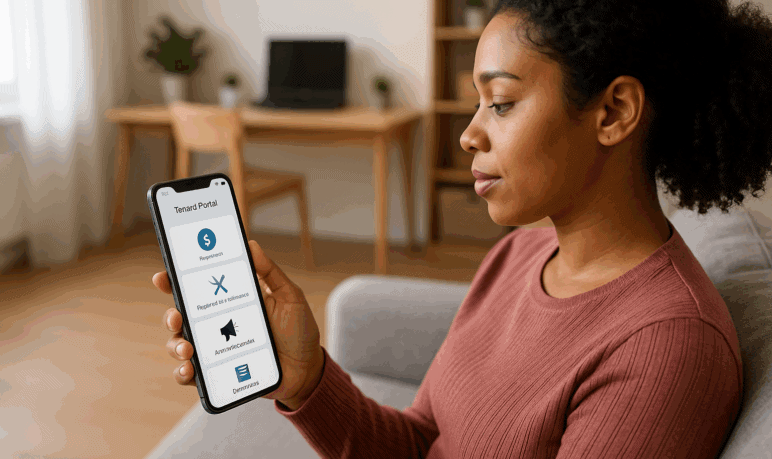
by Inez Kim August 7, 2025
The modern rental market is shaped not just by location and pricing, but also by the experience tenants have throughout their lease. Today’s renters, especially millennials and Gen Z, expect digital convenience, transparency, and quick communication. For property managers, meeting these expectations is no longer optional. Technology has become a key driver in delivering a seamless tenant journey, from move-in to move-out.
Using platforms like portals, mobile apps, and automation tools, property managers can offer convenience, strengthen tenant relationships, and drive long-term retention. These digital tools empower tenants while streamlining operations for landlords.

Tenant Portals and Mobile Apps Make Property Services Accessible
In a digital-first world, tenants don’t want to chase down their managers to get a copy of their lease or ask about a maintenance request. They want fast, 24/7 access to their rental information and services. That’s exactly what tenant portals and mobile apps are designed to offer.
What Is a Tenant Portal?
A tenant portal is a secure online platform or mobile app that connects residents directly with the property management system. Tenants can log in to view their payment history, check their rent balance, download documents such as leases and receipts, or even submit maintenance requests. Some platforms also support messaging features, where tenants can contact the property manager or receive real-time updates on building notices.
These tools provide major tenant portal benefits, especially by reducing the need for in-person office visits or lengthy phone calls. Tenants enjoy the convenience of managing rental-related tasks on their own schedule, and property managers benefit from reduced administrative burden.
Meeting Expectations for Transparency and Self-Service
With self-service tools built into the portal or app, tenants can take care of everyday tasks without waiting for business hours. Whether it’s downloading their rent receipt, updating contact information, or reviewing community guidelines, residents appreciate having access at their fingertips. This level of convenience contributes to a smoother experience and builds trust with the property management team.

Online Rent Payments Offer Simplicity and Peace of Mind
One of the most appreciated features in rental tech today is the ability to pay rent online. As digital banking and contactless payments become the norm, tenants expect the same level of convenience when paying for their homes.
How Digital Payments Improve the Experience
By offering rent payment options through ACH, debit card, or credit card, property managers give tenants flexibility and control. Tenants no longer need to write checks or visit an office to make a payment. Instead, they can pay from their phone or laptop in just a few clicks.
This ease of payment adds directly to the tenant experience property management teams are aiming to improve. Many platforms also include features like autopay, which reduces the risk of late fees, and payment reminders, which help tenants stay on schedule. These capabilities create a smoother process for both sides.
Less Friction, Fewer Late Payments
When the payment process is straightforward and timely, it reduces tenant stress. At the same time, it supports the financial health of the property by lowering instances of late or missed payments. Property managers can spend less time chasing rent and more time focusing on service quality and retention efforts.

Maintenance Request Tracking Builds Tenant Trust
A major source of frustration for renters is maintenance delays or poor communication around repair requests. With traditional systems, tenants might call or email an issue, only to wonder when it will be addressed. Today’s platforms solve this problem by making the process more transparent.
Submitting and Tracking Requests Online
Tenants can now submit maintenance requests directly through the portal or app. Some platforms even allow tenants to upload photos of the issue, making it easier for maintenance teams to assess the situation in advance. Once submitted, the request is logged into the system, and tenants can track its progress—from acknowledgment to resolution.
This transparency significantly improves tenant satisfaction rentals. Tenants feel reassured that their concern has been received and is being acted upon, which reduces uncertainty and stress.
Feedback and Ratings Close the Loop
Certain property management systems include post-repair surveys or allow tenants to rate the maintenance service they received. This feedback not only helps improve internal processes but also demonstrates that management values the tenant’s opinion. These closing steps add a sense of completeness to the maintenance interaction, enhancing overall satisfaction.
Communication and Notifications Keep Tenants Informed
One of the most essential aspects of managing a rental property is timely communication. From emergency repairs to community announcements, being able to reach tenants quickly and clearly is crucial.
Mass Announcements and Push Notifications
Using tenant communication software, property managers can send out mass messages about important updates, such as maintenance schedules, weather alerts, or service interruptions. Notifications can be delivered via email, text message, or app push notification, depending on tenant preferences.
This improves transparency and fosters a better relationship between tenants and managers. Being informed prevents confusion and frustration, especially when issues like water outages or repair work occur.
Two-Way Messaging Enhances Responsiveness
Some platforms support two-way messaging between tenants and property staff, either through direct chat or integrated messaging tools. Tenants can ask questions or raise concerns and receive responses in a timely manner. In certain systems, AI chatbots can handle frequently asked questions, offering immediate answers even outside of office hours.
This functionality ensures communication is not just efficient, but also documented. Both parties benefit from a clear record of interactions, which can help resolve disputes or clarify expectations.
Community Engagement Adds Value Beyond the Lease
While basic services are essential, community-building features can elevate the resident experience. Creating a sense of belonging leads to stronger emotional ties and ultimately better lease retention.
Digital Tools for Community Features
Some tenant communication software includes community features such as digital bulletin boards, neighborhood calendars, or in-app referral programs. These tools give tenants a sense of being part of something larger than just their unit. Managers can also use these tools to organize contests, share news, or promote resident events.
Even when such features are not built-in, property managers can still use the communication tools to foster community. Sending birthday wishes, holiday greetings, or hosting resident appreciation days through the app helps create meaningful interactions.
Building Relationships That Support Retention
Tenants who feel like they are part of a connected, responsive community are far more likely to stay. Investing in community-building tools is one of the more underrated ways to improve tenant satisfaction rentals. It reflects a shift from transactional property management to one that values long-term relationships.
Personalization and Self-Service Empower Tenants
One of the main reasons residents enjoy digital tools is the control they offer. Resident self-service tools reduce dependence on property staff and allow tenants to manage their own living experience with confidence.
Managing Preferences and Appointments
From updating personal details to setting preferences for communication, tenants can fine-tune their settings according to their lifestyle. Some systems even allow residents to choose time slots for maintenance appointments, which adds a level of predictability and respect for their schedule.
Access to Records and Documentation
Tenants can access important records such as past rent payments, lease agreements, or notices anytime through the app or portal. This ensures they always have the information they need without having to wait for office hours or depend on staff.
Giving tenants the ability to handle things on their own builds trust and reinforces a positive relationship. It’s another step toward building a better tenant experience property management teams aim for.
The Business Impact: Retention and Positive Reviews
While all these features benefit the tenant, they also deliver measurable outcomes for property managers. A good tenant experience has a direct impact on business performance, especially in areas like lease renewals and online reputation.
Higher Retention, Lower Turnover Costs
When tenants are happy with their rental experience, they are more likely to renew their lease. This helps avoid the time and cost involved in marketing the unit again, screening new tenants, and preparing the space for re-occupancy. According to industry insights, properties that actively use digital tools to engage tenants often report higher retention rates.
Even a small improvement in retention can lead to significant savings over time. For example, if your turnover costs average $1,500 per unit, retaining just five more tenants per year saves $7,500.
Reputation Drives Referrals and Leads
Today’s renters pay attention to online reviews. Satisfied tenants often leave positive reviews when they feel heard, respected, and well-served. They also refer friends and family to properties they trust. Platforms that offer surveys, testimonial features, or links to review sites help capitalize on this goodwill.
When residents consistently use tenant communication software and are happy with the experience, that story gets shared. Whether on social media or through word-of-mouth, a strong tenant experience drives organic growth.
Looking Ahead: Technology as a Long-Term Strategy
Technology adoption is no longer a luxury in the rental market. It’s a requirement for keeping pace with changing tenant expectations. Renters are used to using mobile apps to order food, pay bills, and book services. They now expect that same convenience from their property management experience.
Embracing tools like tenant portals, mobile apps, and resident self-service tools is a strategic decision. These tools reduce the burden on staff, improve operational efficiency, and create a better living experience for tenants. Whether it’s offering 24/7 rent payment access, real-time communication, or digital maintenance tracking, technology helps properties stand out in a competitive market.
The goal is simple: meet tenants where they are and give them control. When that happens, everyone benefits—residents feel respected, property managers gain efficiency, and businesses see better retention and reputation outcomes.
Frequently Asked Questions
What is a tenant portal?
A tenant portal is a secure online platform or mobile app where renters can manage various aspects of their lease. It allows tenants to pay rent, submit maintenance requests, view their ledger, download documents like receipts or lease agreements, and communicate directly with property management. These portals offer 24/7 access, making it easy for tenants to handle rental tasks without visiting the office or calling during business hours.
How do mobile apps benefit renters?
Mobile apps enhance the tenant experience by providing on-the-go access to essential services. Through the app, renters can pay rent, receive updates, request maintenance, and message management. This immediate access increases convenience, reduces delays, and supports a self-service lifestyle that today’s tenants expect.
Can I pay rent online using these tools?
Yes, most tenant portals and apps allow online rent payments using ACH transfers, credit cards, or debit cards. These platforms also offer helpful features like autopay, instant payment confirmations, and reminders before the due date. This simplifies the process, reduces the risk of late fees, and removes the hassle of paper checks.
How do maintenance requests work in tenant portals?
Tenants can report maintenance issues directly through the portal or app, often with the option to attach photos. Once submitted, the request is logged and trackable, so tenants can monitor progress and get real-time updates. Some systems even let tenants rate the repair experience afterward, giving them a voice and helping property managers maintain high service standards.
Do these platforms support two-way communication?
Yes, many tenant communication tools support two-way messaging between renters and property managers. Tenants can ask questions or raise concerns and receive replies within the app or via email or text. Some platforms also offer AI chatbots for instant answers to frequently asked questions, improving responsiveness even outside office hours.
What are the benefits of resident self-service tools?
Resident self-service tools give tenants the power to manage their own rental experience. These tools let tenants update contact information, download rent receipts, schedule maintenance, or choose communication preferences—all without needing assistance. This autonomy not only increases convenience but also builds trust and satisfaction.